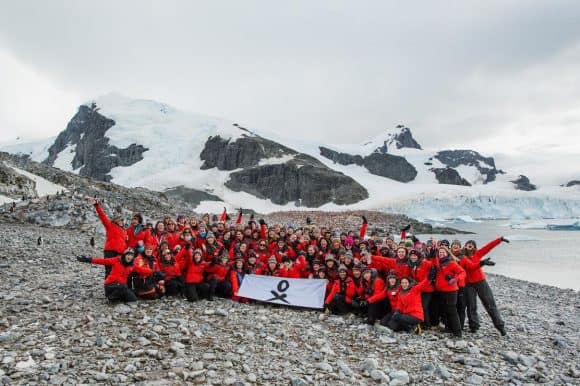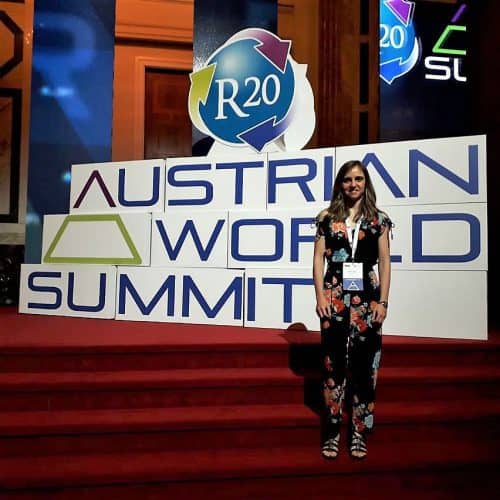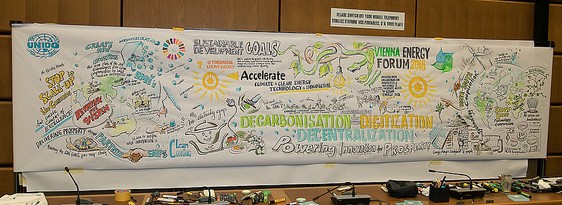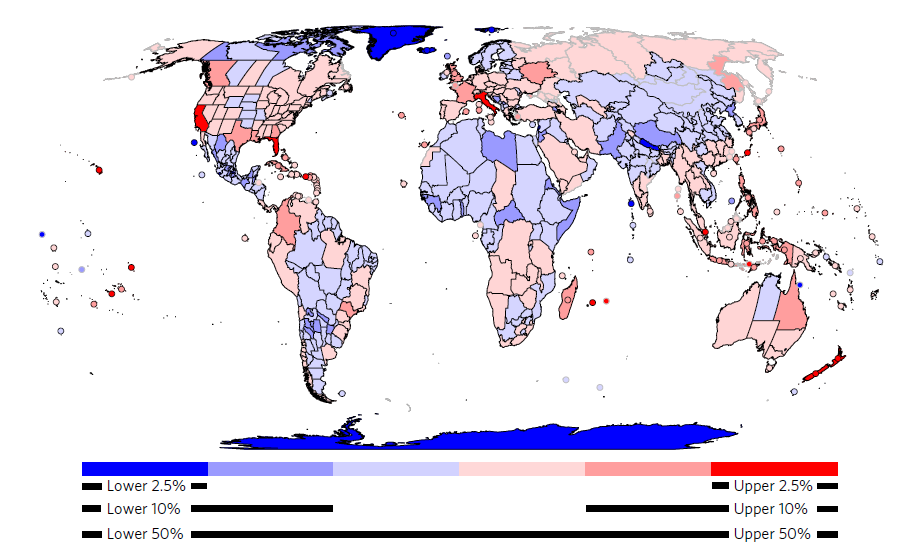Aug 27, 2018 | Data and Methods, Ecosystems, Postdoc
by Melina Filzinger, IIASA Science Communication Fellow
Ecosystems worldwide are changed by the influence of humans, often leading to the extinction of species, for example due to climate change or loss of natural habitat. But it doesn’t stop there: as the different species in an ecosystem feed on each other and are thereby interconnected, the loss of one species might lead to the extinction of others, which can even destabilize the whole system. “In nature, everything is connected in a complex way, so at first glance you cannot be sure what will happen if one species disappears from an ecosystem,” says IIASA postdoc Mateusz Iskrzyński.
This is why the IIASA Evolution and Ecology (EEP) and Advanced Systems Analysis (ASA) programs are employing food-web modeling to find out which properties make ecosystems particularly vulnerable to species extinction. Food webs are stylized networks that represent the feeding relationships in an ecosystem. Their nodes are given by species or groups of species, and their links indicate how biomass cycles through the system by means of eating and being eaten. “This type of network analysis has a surprising power to uncover general patterns in complex relationships,” explains Iskrzyński.
Every one of these food webs is the result of years of intense research that involves both data collection to assess the abundance of species in an area, and reconstructing the links of the network from existing knowledge about the diets of different species. The largest of the currently available webs contain about 100 nodes and 1,000 weighted links. Here, “weighted” means that each link is characterized by the biomass flow between the nodes it connects.
Usually, food webs are published and considered individually, but recently efforts have been stepped up to collect them and analyze them together. Now, the ASA and EEP programs have collected 220 food webs from all over the world in the largest database assembled so far. This involved unifying the parametrization of the data and reconstructing missing links.
The researchers use this database to find out how different ecosystems react to the ongoing human-made species loss, and which ones are most at risk. This is done by removing a single node from a food web, which corresponds to the extinction of one group of species, and modeling how the populations of the remaining species change as a result. The main question is how these changes in the food web depend on its structural properties, like its size and the degree of connectedness between the nodes.
From the preliminary results obtained so far, it seems that small and highly connected food webs are particularly vulnerable to the indirect effects of species extinction. This means that in these webs the extinction of one species is especially likely to lead to large disruptive change affecting many other organisms. “Understanding the factors that cause such high vulnerability is crucial for the sustainable management and conservation of ecosystems,” says Iskrzyński. He hopes that this research will encourage more, and more precise, empirical ecosystems studies, as reliable data is still missing from many places in the world.
As a next step, the scientists in the two programs are planning to understand which factors determine the impact that the disappearance of a particular group of organisms has. They are going to make the software they use for their simulations publicly available, together with the database they developed.
Note: This article gives the views of the author, and not the position of the Nexus blog, nor of the International Institute for Applied Systems Analysis.
Aug 23, 2018 | Ecosystems, Food

© Huating | Dreamstime.com
By Sandra Ortellado, 2018 Science Communication Fellow
China is the world’s biggest producer of both wild and farmed fish, yet the massive commercial fishing industry threatens thousands of years of tradition in ocean and freshwater fishing, as well as the livelihoods of coastal fishing communities.
In the past decade, some coastal ecosystems and environments have been destroyed and polluted in the process of industrialization. Millions of tons of fish are caught in Chinese territorial waters each year, such that overfishing of high value commercial species has led to a drastic decline of some native fisheries resources and species.
In response, the Chinese government released a five-year plan for protecting marine ecosystems and restoring wild capture fisheries. The plan promotes an agenda of “ecocivilization,” which emphasizes land–sea coordination, green development, and social–ecological balance.
It also calls for the introduction of additional output control measures, which directly limit the amount of fish coming out of a fishery. Existing input control measures restrict the intensity of gear used to catch fish, but they may not be sufficient to protect ecosystems.
Yi Huang, a member of this year’s YSSP cohort, has made it her goal to figure out how social ecological balance can be achieved even as fishery regulations shift towards increased input and output control.
Given the size of China’s fishing industry, large scale change requires the abstract concepts of “ecocivilization” to be translated into action, compliance, and enforcement at the local level. That means engaging with individual fishers, their communities, and their way of life, says Huang.
“If you want to control overfishing; the object of fishery management policy are fishers. So you need to understand human behavior to help you control overfishing.”
Huang’s project investigates how changes in fishery management will affect demographic, geographic, and socioeconomic trends in the Chinese fisher population. With the guidance of her supervisors, she’s also developing a bioeconomic model to analyze how output control measures like catch limits will affect ecological and socioeconomic conditions.
“I just want to figure out how to improve enforcement of this kind of policy and see if we can use it to solve the overfishing problem at the same time as giving those in the fishing industry a better life,” says Huang.
Current input control measures like licensing systems, vessel buyback programs, closed seasons, restricted areas, and fisher relocation programs are meant to discourage overfishing and transition towards more sustainable practices. Nevertheless, a decline in fishing vessels and restricted fishing seasons only resulted in an increase in total vessel engine power and large spikes in fishing activity just prior to the closed season.
According to the Chinese fishery statistical yearbook, the number of people employed in the fishing industry proliferated to 13.8 million in 2016, so in recent years the government has issued subsidies encouraging fishers not to fish in the off-season and to change vocation. Older fishers are hesitant to abandon an identity that has been passed down from generation to generation in their families. However, younger generations with access to higher education are lured by the prospect of more stable work outside of their fishing communities, which could really change the socioeconomic and demographic structure of coastal villages.
With the potential for increased output controls to incur drastic changes in coastal communities, it’s more important than ever that regulations are carefully designed with both socioeconomic and ecological factors in mind.
Huang hopes her research will help inform the process of policy development, which involves balancing the needs of both vulnerable fisheries labor and delicate ecosystems.
“When policymakers want to use output control in fishery management, maybe they will think more about the fisher or the socioeconomic aspect of the resolution,” says Huang.
“My research is at the national level, but when they design a regulation it’s at the local level, so my research can teach them how socioeconomic surveys at the local level can be used together with ecological research when they are preparing for regulations.”
Huang, who studied sociology at the Ocean University of China before starting as a PhD student in Marine Affairs at Xiamen University, has spent the past ten years researching coastal fishing communities. She has a deep fondness for the people she surveyed, who welcomed her into their homes and showed her the beauty of the environment that sustained them.
“I want to protect the ocean and the people that connect with it,” says Huang.
A sociological perspective has given Huang an eye for nuance and an appreciation for things that don’t turn out quite how you expect, as they often don’t in scientific research—especially when it attempts to explain human behavior.
For example, Huang says that although fishers may look like countryside people, they act very differently from farmers.
“The ocean has a lot more risk involved than planting on land,” explains Huang.
Because Chinese fishery regulation is currently focused almost exclusively on analyzing resources from an ecological perspective, she thinks sociology and anthropology research could add another revealing dimension to the approach.
“After doing surveys and analyzing the data, I will find maybe I’m wrong or maybe there is something more. That’s why I’m really interested in this kind of research,” says Huang.
As her research project develops, Huang says she’s grateful for the feedback of her supervisors and peers at IIASA, who both challenge and encourage her.
“Even when they have some critical comments on my research, I feel more confident that my research is meaningful, that they support me, and that they’re really interested in my research,” says Huang. “That’s what I can feel every day.”
Jul 5, 2018 | Climate Change, Ecosystems, Environment
By Anatoly Shvidenko, senior researcher in the IIASA Ecosystems Services and Management Program
The forest region known as the circumpolar boreal belt comprises almost a third of the global forest area and about a fourth of the world’s wetlands. There are substantive structural, ecological and management similarities and connections between boreal and global mountain forests of high elevation. Specific features of both boreal and high-elevation forests – or as we started calling them cool forests – include evolutionary adjustments to cold climates; dominance of coniferous species; permafrost over huge territories; vulnerability to climate anomalies and ecological disturbances; large remote and practically unmanaged territories; and lack of infrastructure over vast areas. Under climate change, these landscapes are on the one hand exposed to extreme pressures and risks and on the other, they are decisive for our efforts to reach the climate goals. These cool forests could substantially help to cool down the climate. This is why I became a Cool Forest Ambassador.

© RikoBest | Shutterstock
A particular threat to global climate mitigation efforts is the thawing permafrost, which contains about 1,000 billion tons of carbon as methane and hydrates in the frozen grounds of the Northern Eurasian high latitudes alone. Furthermore, a number of models predict forest deaths over large areas, loss of biodiversity, and negative impacts on social hotspots in the highly populated southern (mid-latitude) ecotone of the boreal zone.
Since the most critical climate change on the planet is expected in continental regions of the boreal and mountainous regions, these forest and wetland landscapes require specific societal, scientific, and managerial attention. The current paradigm of co-evolution of people and forests calls for a transition to adaptive and risk-resilient sustainable forest management (ASFM), which is a complicated task, both mentally and professionally.
Diversity of forests, ownership, socioeconomic conditions, forest management practices, and policies for cool forests are extensive, as are the above-mentioned associated risks. Large differences prevail in stakeholder preferences, understanding, and the valuation of ecosystem services, as well as in understanding relevant strategies of implementing ASFM. We need to advocate the investigation of socioecological drivers that define current and future states, the resilience and vulnerability of forests, as well as the stability of forests and agro-forest landscapes. Moreover, we need to consider the close connection of cool forests with the specifics of surrounding landscapes within the paradigm of the multi-functional use of forests.

© IBFRA
About 20 countries have cool forests, but three of them comprise almost 90% of the total area: Russia 56%, Canada 27%, and the USA 6%. The starting point, preparedness, and capacity of these countries to introduce ASFM are substantially different, but the majority of them are lagging behind in terms of real progress in the proper direction. Cross-border analysis of national specifics and commonalities are needed to understand the potential and challenges of ASFM, as well as to identify problems that cannot be completely resolved by means of ASFM alone (e.g., slowdown of permafrost thaw). There is no silver bullet strategy that would allow us to reach all the goals of ASFM. The high uncertainty of climatic predictions and lack of knowledge on the behavior of boreal and high-elevation forests under new environmental conditions, require new operative information, as well as a new philosophy and management tools. In particular, new types of models are needed to present sufficient information for decision making within regional forest management systems. The IIASA Ecosystem Services and Management Program has intensively studied cool forests for the last three decades (large international projects included SIBERIA-II, Siberia-II, the Third Millennium Ecosystem Assessment etc.).
All pressing problems, hot topics, and required actions related to cool forests will be discussed at the 18th Conference of the International Boreal Forest Research Association “Cool forests at risk? The critical role of boreal and mountain ecosystems for people, bioeconomy, and climate”, taking place at IIASA from 17 to 20 September 2018. More information about this event is available on the conference website (IBFRA18.org). We invite scientists and stakeholders from policy, business, and civil society and all who are interested in the topic, to express their opinion about the most important and urgent actions that should be realized. Join me in signing-up as a Cool Forest Ambassador to bring this globally important problem to the attention of societies and governing circles globally.
Note: This article gives the views of the authors, and not the position of the Nexus blog, nor of the International Institute for Applied Systems Analysis.
Jun 18, 2018 | Alumni, Ecosystems, Environment, Women in Science, Young Scientists
By Cecile Godde, PhD student at the University of Queensland, Australia and former IIASA YSSP participant

Cecile Godde ©Oli Sansom
Last year, I had the fantastic opportunity to spend three months at IIASA as part of the Young Scientists Summer Program (YSSP), to collaborate with the Ecosystems Services and Management (ESM) research program. During this very enriching experience, both intellectually, socially, and culturally, I worked with Petr Havlik, David Leclère, and Christian Folberth on modeling global rangelands and pasturelands under farming and climate scenarios. I also progressed on the development of a global animal stocking rate optimizer. The overall objective of this YSSP project, and more broadly of my PhD, is to assess the role of grazing systems in a sustainable food system.
However, my trip to IIASA was not my only adventure last year. Just before moving to Vienna, I received the great news that I was selected along with 77 other women to take part in a women in science and leadership program called Homeward Bound.
What would our world look like if women and men were equally represented, respected, and valued at the leadership table? How might we manage our resources and our communities differently? How might we coordinate our response to global problems like food security and climate change?
Homeward Bound is a worldwide and world-class initiative that seeks to support and encourage women with scientific backgrounds into leadership roles, believing that diversity in leadership is key to addressing these complex and far-reaching issues. The program’s bold mission is to create a 1000-strong collective of women in science around the world over the next 10 years, with the enhanced leadership, strategic, and visibility capacity to influence policy and decision making for the benefit of the planet.

Antarctic penguins © Cecile Godde
This year-long program culminated in an intensive three-week training course in Antarctica, a journey from which I have just come back. The voyage to Antarctica was incredible. We learnt intensively during this 24/7 floating conference in the midst of majestic icebergs, very cute penguins, graceful whales, and extraordinary women from various cultures and backgrounds, from PhD students to Nobel Laureates. I have returned full of hope for the planet, deeply inspired, and emotionally energized. It was a truly unforgettable experience, one that will keep me reflecting for a lifetime.
Our days in Antarctica typically followed a similar routine – half of the day was dedicated to a landing (we visited Argentinian, Chinese, US, and UK research stations) and the other half to classes and workshops. We discussed systemic gender issues and learnt about leadership styles, peer-coaching, the art of providing feedback, science communication, core personal values, or what matter to us. The list goes on! We were also encouraged to practice reflective journaling. Regularly recording activities, situations, and thoughts on paper is actually a very powerful technique for self-discovery and personal and professional growth as it helps us think in a critical and analytical way about our behaviors, values, and emotions. We also spent quite some time developing our personal and professional strategies: What is our purpose as individuals? What are our core values, aspirations, and short- and long-term goals? From that, we developed a roadmap that could be executed as soon as we stepped off the ship. While I haven’t solved all my life’s mysteries, this activity gave me strong foundations to keep growing and actively shape my own life, rather than letting society do it for me.
In the evenings, we watched our film faculty sharing their tips with us on television, including primatologist Jane Goodall, world leading marine biologist Sylvia Earle, and former Executive Secretary of the UN Framework Convention on Climate Change (UNFCC), Christiana Figueres. We also had a collective art project called “Confluence: A Journey Homeward Bound”, which was underpinned by our inner journey of reflection, growth, and transformation and our outer physical journey to Antarctica.

Homeward Bound in Antarctica © Oli Sansom
Both my stay at IIASA and my journey to Antarctica taught me a lot about the value of getting out of my comfort zone, exploring different leadership styles, and collaborating. I have also witnessed how visibility (visibility to ourselves, to understand who we are, and visibility to others, to let the world know we exist) helps to open up opportunities. The good news is that the beliefs we have about ourselves are just that – beliefs – and these beliefs can be changed.
My visibility to others has also increased notably in relation to my involvement in Homeward Bound and my recent award of the Queensland Women in STEM prize. This Australian annual prize, awarded by the Minister for Environment and Science, Leeanne Enoch and Acting Chief Scientist Dr Christine Williams, aims to celebrate the achievements of women who are making a difference in the fields of science, technology, engineering, and mathematics. As a result, I have been contacted by fascinating people from various fields of work, from researchers and teachers to entrepreneurs, start-ups, and industries. All these connections have broadened my approach to food security and global change and helped me shape my research vision, purpose, and values.
When we were in Antarctica, our story reached 750 million people. Why? Because, and may we never forget, the world believes in us – ‘us’ in its broadest sense: humans, scientists, women, etc. – in our skill, compassion, and capability. While we are facing alarming global social, economic, and environmental challenges, I believe that the many collaborations that embrace diversity of knowledge, skills, processes, and leadership styles that are currently emerging all around the world, will help us get closer to our development goals.
Homeward Bound is a 10-year long initiative. Find out more about the program and how to apply here: http://homewardboundprojects.com.au
Follow my journey: –
May 28, 2018 | Air Pollution, Climate, Climate Change, Ecosystems, Energy & Climate, Women in Science
By Beatriz Mayor, Research Scholar at IIASA
On 14 and 15 May, Vienna hosted two important events within the frame of the world energy and climate change agendas: the Vienna Energy Forum and the R20 Austrian World Summit. Since I had the pleasure and privilege to attend both, I would like to share some insights and relevant messages I took home with me.

Beatriz Mayor at the Austrian World Summit © Beatriz Mayor
To begin with, ‘renewable energy’ was the buzzword of the moment. Renewable energy is not only the future, it is the present. Recently, 20-year solar PV contracts were signed for US$0.02/kWh. However, renewable energy is not only about mitigating the effects of climate change, but also about turning the planet into a world we (humans from all regions, regardless of the local conditions) want to live in. It is not only about producing energy, about reaching a number of KWh equivalent to the expected demand–renewables are about providing a service to communities, meeting their needs, and improving their ways of life. It does not consist only of taking a solar LED lamp to a remote rural house in India or Africa. It is about first understanding the problem and then seeking the right solution. Such a light will be of no use if a mother has to spend the whole day walking 10 km to find water at the closest spring or well, and come back by sunset to work on her loom, only to find that the lamp has run out of battery. Why? Because her son had to take it to school to light his way back home.
This is where the concept of ‘nexus’ entered the room, and I have to say that more than once it was brought up by IIASA Deputy Director General Nebojsa Nakicenovic. A nexus approach means adopting an integrated approach and understanding both the problems and the solutions, the cross and rebound effects, and the synergies; and it is on the latter that we should focus our efforts to maximize the effect with minimal effort. Looking at the nexus involves addressing the interdependencies between the water, energy, and food sectors, but also expanding the reach to other critical dimensions such as health, poverty, education, and gender. Overall, this means pursuing the Sustainable Development Goals (SDGs).

Vienna Energy Forum banner created by artists on the day © UNIDO / Flickr
Another key word that was repeatedly mentioned was finance. The question was how to raise and mobilize funds for the implementation of the required solutions and initiatives. The answer: blended funding and private funding mobilization. This means combining different funding sources, including crowd funding and citizen-social funding initiatives, and engaging the private sector by reducing the risk for investors. A wonderful example was presented by the city of Vienna, where a solar power plant was completely funded (and thus owned) by Viennese citizens through the purchase of shares.
This connects with the last message: the importance of a bottom-up approach and the critical role of those at the local level. Speakers and panelists gave several examples of successful initiatives in Mali, India, Vienna, and California. Most of the debates focused on how to search for solutions and facilitate access to funding and implementation in the Global South. However, two things became clear. Firstly, massive political and investment efforts are required in emerging countries to set up the infrastructural and social environment (including capacity building) to achieve the SDGs. Secondly, the effort and cost of dismantling a well-rooted technological and infrastructural system once put in place, such as fossil fuel-based power networks in the case of developed countries, are also huge. Hence, the importance of emerging economies going directly for sustainable solutions, which will pay off in the future in all possible aspects. HRH Princess Abze Djigma from Burkina Faso emphasized that this is already happening in Africa. Progress is being made at a critical rate, triggered by local initiatives that will displace the age of huge, donor-funded, top-down projects, to give way to bottom-up, collaborative co-funding and co-development.
Overall, if I had to pick just one message among the information overload I faced over these two days, it would be the statement by a young fellow in the audience from African Champions: “Africa is not underdeveloped, it is waiting and watching not to repeat the mistakes made by the rest of the world.” We should keep this message in mind.
Aug 11, 2017 | Ecosystems, Young Scientists
By Caroline Njoki, IIASA Science Communication Fellow 2017
Wealthier regions with high population densities have the largest influxes of non-native species, a new study has found. This is mainly because of global trade and strong transport links, the researchers concluded.
Researchers assessed global patterns from 609 regions consisting of 186 islands and 423 mainland regions. Using available global and national databases as well as a thorough literature search for eight taxonomic groups (vascular plants, birds, freshwater fishes, ants, spiders, amphibians, mammals and reptiles), they identified hotspots with high and low diversity of non-native species. Socioeconomic and environmental factors such as climate were also taken into consideration.

Map showing hotspots with high (dark, medium and light red) and low (dark, medium and light blue) diversity of non-native species across the eight taxonomic groups. Source: Dawson W et al. (2017).
The results indicate that remote and highly populated islands, developed countries, and nations with fast growing economies have the greatest influxes of invasive species from across the taxonomic groups due to reliance on foreign commodities. This also applies to coastal regions that have seaports serving as import hubs for non-native birds and aquatic organisms. The rate of invasion is especially high on islands and in coastal regions with warmer climates.
Native, endemic, and rare plants and animals could be particularly vulnerable in these regions, especially if the absence of predators or reduced numbers of competitors on islands allows invasive species to thrive. Under climate change, urbanization, and land-use intensification, non-native species might also be able to increasingly spread into environments that were previously unviable for them.
‘‘Horticultural products from other regions are among the commodities accounting for a large influx of non-native plants and arthropods (spiders), especially in Europe and North America,” said coauthor of the study Bernd Lenzner, a PhD student at the University of Vienna and a participant in the IIASA Young Scientist Summer Program.

Lenzner’s work at IIASA to predict future patterns up to year 2050, is critical to help guide development of appropriate strategies to tackle species such as the Hottentot fig (seen here with purple flowers) originally from South Africa but invasive in Mediterranean coastal habitats © Bernd Lenzner | IIASA
Several regional initiatives enabling the public to participate in monitoring and reporting of invasive species through user-friendly digital applications exist, like the “Invasive Alien Species Europe” app. This contains photos and fact sheets of a number of species that have become invasive in Europe to allow users to identify and submit information regarding occurrences of species of concern.
Lenzner’s current work at IIASA is to develop models indicating likely future patterns of invasive species at a global scale by integrating data from several models, including the IIASA Global Biosphere Management Model. Construction of the models is based on information collated from climate change, population dynamics, the resilience of native biodiversity, legislation, trade, transport activities, and land-use and land-cover change. The research will provide predictions up to the year 2050, to guide policymakers to develop appropriate strategies to tackle non-native species.
To ensure wider applicability, the work is linked to the IIASA-led Shared Socioeconomic Pathways (SSPs). The SSPs provide alternative explanations on how various elements, such as governance, urbanization, and economic growth, might develop in the future. Some of these factors will have crucial impacts on the displacement and establishment of non-native species.
“Forecasting future scenarios, though necessary, may be hindered by uncertainty over the probable impacts, and scattered and insufficient data. This is further complicated by a lack of a clear definition of invasive species. More funding and research effort are required to generate comprehensive information vital for effective management of invasive species if the Aichi Target 9 by the Convention on Biological Diversity is to be realized by year 2020,” says Lenzner.

Nile perch was introduced to Lake Victoria, East Africa for its beneficial traits but has eliminated many native fish © Fotogien | Shutterstock
Global trade has developed rapidly, with advances in transport enabling easier and faster movement of goods and people in high volumes. The rising human population also drives the demand for commodities. This global trade network opens the door for species to spread across the world. In addition, non-native species are sometimes deliberately or accidentally introduced, often in the form of ornamental, agricultural, and forestry products, or because of research, natural disasters, and the pet trade.
“Some countries introduce species for their beneficial traits without conducting proper risk assessments, only to suffer from the resulting impacts later on. For instance, Nile perch in Lake Victoria, East Africa has eliminated many native and endemic fish. It takes a while for certain introduced species to exhibit invasive characteristics as they adapt to their new environment or conditions become more favorable,” said Lenzner.
The findings are important, especially for countries at greater risk of invasion, to help policymakers put measures in place to stop further introductions and the spread of non-native species. The move aims to safeguard human health, economies, infrastructure, native organisms and associated environmental goods and services.
About the researcher
Bernd Lenzner is a third year PhD student at the Division of Conservation Biology, Vegetation and Landscape Ecology at the University of Vienna. His research focuses on understanding spatial and temporal patterns and processes of global naturalized alien plant species richness and assembly. At IIASA, Bernd is working with the Ecosystem Services and Management Program to develop the first global scenarios for biological invasion in the 21st century under the supervision of David Leclère and Oskar Franklin.
References
Dawson W, Moser D, Kleunen M & Kreft H et al (2017). Global hotspots and correlates of alien species richness across taxonomic groups. Nature Ecology and Evolution 1: 0186
This article gives the views of the author, and not the position of the Nexus blog, nor of the International Institute for Applied Systems Analysis.












You must be logged in to post a comment.